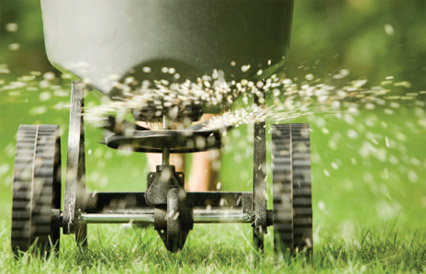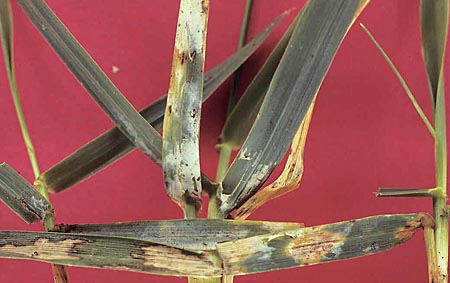Don’t Fertilize Your Lawn in April
By Gil Medeiros, Fairfax Master Gardener
Everyone, it seems, wants you to fertilize your cool-season lawn in April. Fertilizer companies bombard you with their slick, sophisticated, sometimes entertaining television ads. You turn off the TV, but it still doesn’t end. Whenever you walk into a big-box hardware store to buy a furnace filter, you must walk past the colorful displays of plump lawn-fertilizer bags.
 Resist. For the good of your fescue, bluegrass, and perennial rye, resist.
Resist. For the good of your fescue, bluegrass, and perennial rye, resist.
Here’s why: In the early spring, as most plants awaken from dormancy, they want to grow roots. Grass is the same. This priority is hard-wired into the DNA of the plant. It is the accumulated wisdom of eons of survival. The grass sends its roots deep into the soil because summer is coming; the rain may stop, and the heat is certainly on the way. The timing of this root-growth spurt is not the same everywhere. It is governed by climate, which is a function of longitude and latitude. Therefore, the major advertisements of nationally marketed fertilizers, and the splashy promotions in the big-box stores are correct for some parts of the country. Not here. In Fairfax, the fescue and bluegrass awakens to push out new roots in April and early May.
What happens when you feed the grass in April with a lawn fertilizer that contains 20 to 30 percent nitrogen? Nitrogen helps plants grow green, leafy shoots; that’s the part of the grass plant above the ground. When the plant is growing shoots, it slows and eventually shuts down the growth of roots. Root growth is, therefore, stunted as the grass plants take advantage of nitrogen availability to grow luxurious, green, top growth. After fertilizing you feel secure in the knowledge that you have done the right thing by your lawn. It has never looked happier. It appears that Sandy Scott on the Masters golf telecast was right.

Brown patch (Rhizoctonia sp.) on tall fescue
Beyond the advertising blitz, there is another temptation to apply fertilizer at the wrong time. Early April is the right time to apply a pre-emergent product to control crabgrass or a post-emergent product to suppress many of the broadleaf weeds that sprouted in the winter. The problem is that many of those weed-control products are packaged with fertilizer in the bag. Find weed control products without the fertilizer. You may have to go to a garden center for these because many of the big-box stores carry only weed and feed. Early spring is the right time to treat your lawn for weeds, but it is not the right time to fertilize. Resist the temptation to apply a weed-and-feed product.
Is it OK to fertilize in spring? Yes, but not in April. Fertilization at a rate not to exceed a half-pound of nitrogen per 1,000 square feet of lawn should be done in the latter half of May when the grass plants have completed their annual growth of roots. This is the time for the grass to grow shoots above the ground after the root growth has finished for the spring. Mind you, any spring fertilization is a booster shot. Most of your fertilization should have been done the previous fall.
For best results, follow the recommended Virginia Cooperative Extension fertilization program for cool season grasses shown below.
| Nitrogen Application By Month | ||||
| Quality Desired | Sept. | Oct. | Nov. | May 15-June 15 |
| Low | 0 | 1 | 0 | 0-1/2 |
| Medium | 1 | 1 | 0 | 0-1/2 |
| High | 1 | 1 | 1 | 0-1/2 |
There are no guarantees in biology. However, we can say that grass that has not been fertilized in April has a better chance of surviving the tough, mid-summer conditions. The commercial character Sandy Scotts tells you to “Feed your lawn; feed it.” That advice is not bad. Just don’t feed it at the wrong time, and don’t give it too much.
Reference
Lawn Fertilization in Virginia, Publication 430-011, Virginia Cooperative Extension